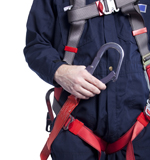 Gravity is a force that we are all bound to and falling or having an object fall on us is something that we all try to avoid. Fall hazards are around us every day. Recognizing the areas at your work location that put people and objects in danger of a fall is the first step in creating a safer work environment for everyone. Putting steps, guardrails, or other fall protection systems in place to take away the hazard will make your workplace safer. Using ladders that are designed for the environment that you are working in is important to the health and safety of your employees. Stray power cords and tools create unnecessary trip and fall hazards. Round objects such as cans or stray scrap material may pose a slip and roll hazard that can cause a fall or twist an ankle. By simply using the three point method when climbing up, down, on, or off of an object you can help to prevent a slip, trip, or fall. Understanding the value of good housekeeping is a must to prevent slips, trips, and falls.
Gravity is a force that we are all bound to and falling or having an object fall on us is something that we all try to avoid. Fall hazards are around us every day. Recognizing the areas at your work location that put people and objects in danger of a fall is the first step in creating a safer work environment for everyone. Putting steps, guardrails, or other fall protection systems in place to take away the hazard will make your workplace safer. Using ladders that are designed for the environment that you are working in is important to the health and safety of your employees. Stray power cords and tools create unnecessary trip and fall hazards. Round objects such as cans or stray scrap material may pose a slip and roll hazard that can cause a fall or twist an ankle. By simply using the three point method when climbing up, down, on, or off of an object you can help to prevent a slip, trip, or fall. Understanding the value of good housekeeping is a must to prevent slips, trips, and falls.
There are many traps in life that create hazardous situations. It is part of your job to know and understand where these so called traps lie. Hazard recognition is a big part of being safe in your everyday life. Another name many people use for hazard recognition is “Life Experience.” Here are several resources that have been shared with me. They cover walking and working surfaces, ladder safety, and fall protection subjects. These should be used to teach people within your company about the hazards, or traps, that they may encounter in the scrap recycling industry. Falls are preventable if we understand where and how they might occur. Preparation and awareness are keys to helping to remove these hazards from your jobsite. Work safely at heights, or not at all.
Tony Smith is the director of safety outreach for ISRI. This blog is part of a series during National Safety Month related to Safety Stand-Down Day, which occurred on June 24.
Learn More